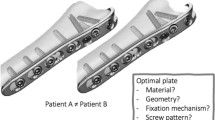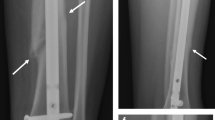Abstract
Composite analogue bone models provide consistent geometric and structural properties that represent a valuable asset in a range of biomechanical analyses and testing procedures. The objective of this study was to evaluate the diaphyseal structural properties of the large-size Fourth-Generation composite analogue femur and tibia models concentrated on mechanical behaviors under axial compression, bending and torsion. Thirty of each large-size composite analogue models (femora and tibiae) were tested under medial-lateral four-point bending, anterior-posterior four-point bending, axial compression and external rotational torque to evaluate flexural rigidity, axial stiffness, torsional rigidity and ultimate failure strength. The composite femur was tested under torsion at both the femoral neck and the mid-diaphyseal areas. Large-size Fourth-Generation composite replicate bones exhibited intra-specimen variations under 10% for all cases and was also found to perform within the biological range of healthy adult bones (age: <80 years old) range with respect to flexural rigidity (<8%) and torsional rigidity (<12%). The failure modes of these composite models were close to published findings for human bones (four-point bending: butterfly fragment fracture; torsional: spiral fracture; and compression: transverse fracture). The large-size composite analogue femur and tibia are close to ideal replicas for standardization in biomechanical analyses. One advantage of these analogue models is that their variability is significantly lower than that of cadaveric specimens for all loading regimens. Published results vary widely in cadaveric studies, which is likely due to the high anatomic variability among cadaveric specimens. This study evaluated and advanced our overall understanding of the capacity of composite analogue bone models mimic the structural properties of average healthy adult human bones.






Similar content being viewed by others
References
Chong, A. C., F. Miller, M. Buxton, and E. A. Friis. Fracture toughness and fatigue crack propagation rate of short fiber reinforced epoxy composites for analogue cortical bone. J. Biomech. Eng. 129(4):487–493, 2007.
Cristofolini, L., and M. Viceconti. Mechanical validation of whole bone composite tibia models. J. Biomech. 33(3):279–288, 2000.
Cristofolini, L., M. Viceconti, A. Cappello, and A. Toni. Mechanical validation of whole bone composite femur models. J. Biomech. 29(4):525–535, 1996.
Dunlap, J. T., A. C. Chong, G. L. Lucas, and F. W. Cooke. Structural properties of a novel design of composite analogue humeri models. Ann. Biomed. Eng. 36(11):1922–1926, 2008; Epub 2008 Sept 17.
Fuerst, A. E., S. Oswald, S. Jäggin, G. Piskoty, S. Michel, and J. A. Auer. Fracture configurations of the equine radius and tibia after a simulated kick. Vet. Comp. Orthop. Traumatol. 21(1):49–58, 2008.
Gonza, E. R. Biomechanical long bone injuries. In: Biomechanics of Musculoskeletal Injury, edited by E. R. Gonza and I. J. Harrington. Baltimore: Williams & Wilkins, 1982, pp. 1–30.
Heiner, A. D. Structural properties of fourth-generation composite femurs and tibias. J. Biomech. 41(15):3282–3284, 2008; Epub 2008 Oct 1.
Heiner, A. D., and T. D. Brown. Structural properties of a new design of composite replicate femurs and tibias. J. Biomech. 34(6):773–781, 2001.
Holzer, G., G. von Skrbensky, L. A. Holzer, and W. Pichl. Hip fractures and the contribution of cortical versus trabecular bone to femoral neck strength. J. Bone Miner. Res. 24(3):468–474, 2009.
Johner, R., H. U. Stäubli, M. Gunst, and J. Cordey. The point of view of the clinician: a prospective study of the mechanism of accidents and the morphology of tibial and fibular shaft fractures. Injury 31(Suppl 3):C45–C49, 2000.
Papini, M., R. Zdero, E. H. Schemitsch, and P. Zalzal. The biomechanics of human femurs in axial and torsional loading: comparison of finite element analysis, human cadaveric femurs, and synthetic femurs. J. Biomech. Eng. 129(1):12–19, 2007.
Tencer, A. F., and K. D. Johnson. Biomechanics in Orthopedaedic Trauma: Bone Fracture and Fixation. London: Martin Dunitz, 1994, p. 43.
Acknowledgments
The authors thank Pacific Research Laboratories, Inc. (Vashon Island, WA) for providing the composite analogue femora and tibiae used in this study. The authors also wish to thank Teresa L. Jones, MPH, MT (ASCP) for her revision and critical comments on this manuscript. No benefits of any form have been received directly or indirectly to the subject of this article.
Author information
Authors and Affiliations
Corresponding author
Additional information
Associate Editor Peter E. McHugh oversaw the review of this article.
Investigation performed at the Orthopaedic Research Institute at Wichita, KS, USA.
Rights and permissions
About this article
Cite this article
Gardner, M.P., Chong, A.C.M., Pollock, A.G. et al. Mechanical Evaluation of Large-Size Fourth-Generation Composite Femur and Tibia Models. Ann Biomed Eng 38, 613–620 (2010). https://doi.org/10.1007/s10439-009-9887-7
Received:
Accepted:
Published:
Issue Date:
DOI: https://doi.org/10.1007/s10439-009-9887-7




